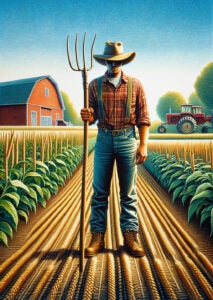When I thought about artificial intelligence (AI) just a few years ago, the idea of it was vastly different from what it is today. Back then, AI was this minor assistance in the background, something we used daily without even realizing it. For instance, I knew AI was behind our autocorrect and tailored our social media advertisements. I knew AI was the “computer” we played against in video games and the technology behind shuffle music. These were tools that supplemented creative spaces.
Fast forward to today, and the scope of AI has expanded tremendously. When you say the words AI, it could be followed by almost anything — AI images, AI videos, AI voices. It’s become a ubiquitous term.
Yes, AI has its benefits. Tools like Grammarly help me catch spelling errors in my articles, and AI makes search engines more effective. In agricultural research, there are times when I wish for AI technology to make tasks easier, although in ag spaces it’s much more costly than your typical AI text generator.
As a scientist and a writer, I acknowledge that AI is making tremendous strides in various fields, including medicine, construction, and agriculture. It’s helpful in data processing and handling tedious work that no one really wants to do. AI also enhances communication for people who don’t understand different languages and provides a voice for those who otherwise wouldn’t have one.

However, it also has significant risks and downsides, especially in creative and communication fields.
Here, I’ll explore communication as part of the creative field, because it involves components of humanities like art, imagery, and social interaction. While agriculture and its related fields — like food production and natural resources — benefit from AI, there are risks I can see arising in ag communications. There’s already a lot of mistrust in such industries, and using AI can exacerbate this. The idea of jobs in creative and communication fields being not only enhanced but replaced is concerning. It brings a dystopian feeling to these spaces that I really don’t like.
As a Gen Z’er, I feel it’s important to mention that not all of us are as on the same track with modern day technology and where it is going, as older generations might think. Many of us have significant concerns about its impact on the future of agriculture in the public eye.
Growing up with social media and this kind of technology gives us a better understanding of the risks and problematic factors that come with AI. The future of agriculture is in the hands of my generation, yet there are very few young farmers compared to older generations. This reality with AI makes the future of ag look shaky, and I know older generations are worried about that too.
It’s crucial to address these concerns from a Gen Z perspective to emphasize that we are also invested in the future of agriculture and its public image.
In ag communications, we manage the public image of agriculture and agricultural literacy, which requires a lot of trust with the public. We need to be careful about using tools that could potentially build mistrust. It’s crucial to consider the implications of AI to ensure we maintain public confidence in our industry.

AI is no longer just about autocorrect or specialized marketing. Today, it generates images using tools like an image generator, as well as videos and even interactions. With just a few clicks, you can create almost any image or video you want and have artificial conversations. AI has become a feature on many platforms, embedded in tools for generating images, text, and even videos and voices. This shift means AI is moving from a supplemental role to potentially replacing many roles in creative spaces.
As a communicator with respect for the arts and humanities, I have deep concerns for those in communication and creative fields. The idea that people can lose jobs in these fields is troubling. People often argue that technological progress is inevitable, comparing it to the disappearance of the milkman. But delivering milk isn’t an aspect of our humanities and arts. Storytelling, writing, and film are fundamental to our culture, and our ag story tellers are not exempt from this.
Animators, for instance, put in hard work to create their animations. It’s unfortunate that people can now use AI to create animations with a few clicks, often resulting in poorly made content. This undermines the passion and effort that go into creative work. Similarly, the roles of graphic designers and writers are at risk. The public deserves genuine, human-crafted art and communication, not lifeless, AI-generated content.

There are significant ethical issues related to AI, particularly regarding likeness and intellectual property. For example, there have been instances where AI-generated voices and images have been used without permission, causing distress and concern about the misuse of technology.
Agricultural communications is a critical field that plays a significant role in maintaining public trust. Agriculture is a controversial industry, encompassing more than just biology and chemistry — it involves legalities and ethical considerations. While agriculture is meant to benefit people, it often faces significant mistrust and controversy.
Ag communicators are essential in managing this controversy and delegating public images. They form a crucial part of the triad of ag literacy, alongside ag education and ag leadership. Ag communicators handle ag literacy through communications — social media, journalism, images, and videos. With only a small percentage of the nation involved in or knowledgeable about the agriculture industry, ag communicators are tasked with informing the public and building trust.
Recently, there was an incident that caused quite a stir in the academic community. The journal Frontiers in Cell Development and Biology published an article featuring an AI-generated image of a rodent’s physiology and anatomy, which was completely inaccurate. This example highlights the potential danger of AI-generated misinformation reaching the public. While this incident suggests that the academic field needs to improve its review processes, it also underscores the risks associated with AI in generating misleading content. (Thankfully, the paper was retracted due to those images.)
When people encounter fake images, videos, or even AI-generated texts from any source, it fosters mistrust. If a company or institution relies on AI-generated content, it raises questions about the authenticity and reliability of their information. Why not use real images or actual research findings? The use of AI-generated content can make people skeptical of the researchers and the field as a whole, eroding trust further. Although one might argue that this could teach us to be better at spotting fake news, the ease with which AI can create misinformation is alarming and should be addressed.
Given the significant role of ag communications in ag literacy, it’s crucial for ag communicators to prioritize transparency and authenticity. Ag communicators have a big job in bridging the gap between the agricultural industry and the public, and this responsibility should not be taken lightly. Using AI-generated content can give a false sense of transparency and authenticity, which can be detrimental to building trust.
I believe that ag communicators should resist the temptation to use AI for creating deceptive content. There are plenty of opportunities to use real content — on the visual side, that would include stock images, personal photography training, or hiring professional photographers. Real content is always better for a brand and more trustworthy.
Using AI-generated content can be seen as deceptive, and in an industry already struggling with public trust, we cannot afford to be deceptive. We must keep it real and ensure the integrity of our work.
The potential misuse of AI tools, such as voice replication and image manipulation, carries significant ethical ramifications. Voice replication is just one of the many potential misuses of AI. For instance, there have been concerns about the unauthorized use of voices to create new content. This kind of misuse can be haunting and disturbing. Image and video manipulation are also significant concerns.
There are many people who are passionate about the creative process, AI should be a tool to aid these professionals, not replace them. The idea of replacing human effort with a few clicks undermines the essence of creativity. Even in roles like graphic design within ag communications, the reliance on AI can lead to job losses and a decrease in the quality of work. It’s essential to preserve these human elements in our creative industries.

I have both hope and skepticism about the future of AI in these spaces. On one hand, AI continues to improve, making it harder to distinguish between real and AI-generated content. This raises valid concerns about the future and the regulation of AI. There’s a risk that people’s likenesses will be continuously violated, and jobs in creative fields will be increasingly replaced.
On the other hand, I am hopeful that the rise of AI will bring people closer together. I believe that people will start to support content created by humans more, rejecting AI-generated content. This could encourage a greater appreciation for genuine human creativity.
In the agricultural sector, AI might help us better detect misinformation, leading to better-informed consumers and more trust in our industry. However, this will require careful and ethical use of AI tools.
AI should serve as a tool to enhance human creativity and integrity, not replace them.
I encourage readers and ag communicators to prioritize the ethical use of AI. We must advocate for responsible AI usage, ensuring that we uphold transparency and authenticity in all our communications. By doing so, we can navigate the technological landscape without losing sight of what makes us uniquely human.
Saul Reyes served as the 2022 American Farmland Trust Agriculture Communications Intern at AGDAILY, with a focus on helping to amplify diversity and minority voices in agriculture. An FFA alum, Reyes is a graduate of California State University-Chico and double majored in plant and soil science and multicultural and gender studies, while minoring in intersectional Chicanx/Latinx studies and public relations. He can be found on Twitter @sreyes710.



